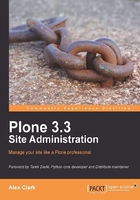
上QQ阅读APP看书,第一时间看更新
Development
Development usually begins with a buildout configuration file checked into a software repository. Initially, this buildout creates a software stack suitable for running the desired version of Plone.
Using this buildout, any developer can join the development team quickly and gain speed fairly easily. As the site administrator, you may be doing some, all, or none of the coding for your site, but you should still be familiar with the process.
Development tasks usually consist of:
- Creation of a policy package: It is necessary for performing various site customizations. Policy in this context usually means: "applies project-specific customizations or features". See Chapter 5 of "Professional Plone Development", Martin Aspeli, Packt Publishing (https://www.packtpub.com/Professional-Plone-web-applications-CMS/book) for more information.
- Theme development: Traditionally, themes are implemented within a theme package that contains CSS and JavaScript files, images, and so on. More recently, you may see Deliverance or XDV-based themes being used (outside of Plone). See "Plone 3 Theming", Veda Williams, Packt Publishing (https://www.packtpub.com/plone-3-theming-create-flexible-powerful-professional-templates/book) for more information.
- Adding features: In addition to customizing Plone's default features, you may need to add new features as well. You can do this by installing existing add-ons or developing new features from scratch.
- Writing tests: Unless you want to click through your site every time you make a code change to make sure that everything still works properly, you will want to write the tests—you will want to write lots of tests. In addition to the practical aspects of testing, good test coverage is a strong indicator of a job well done. See: http://plone.org/documentation/kb/testing for more information.